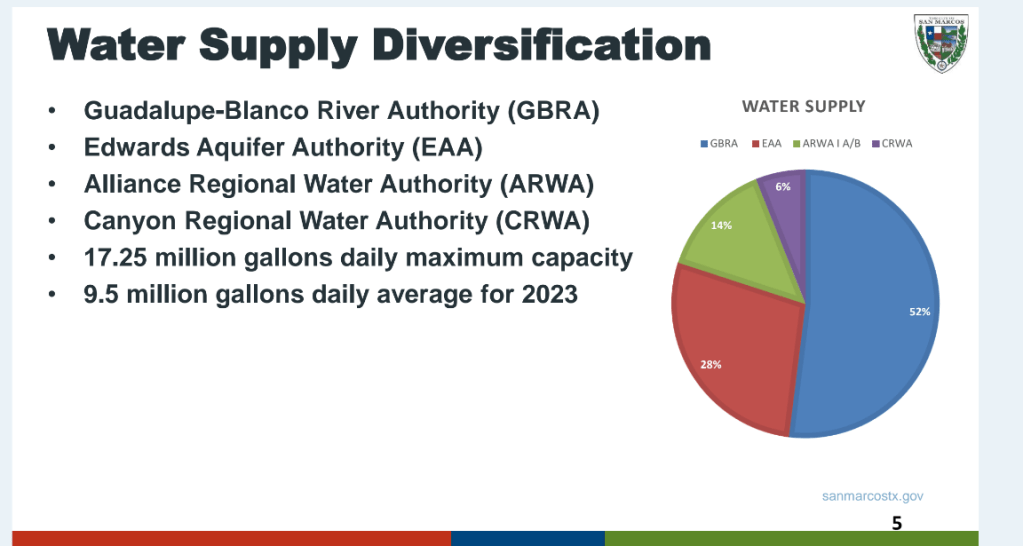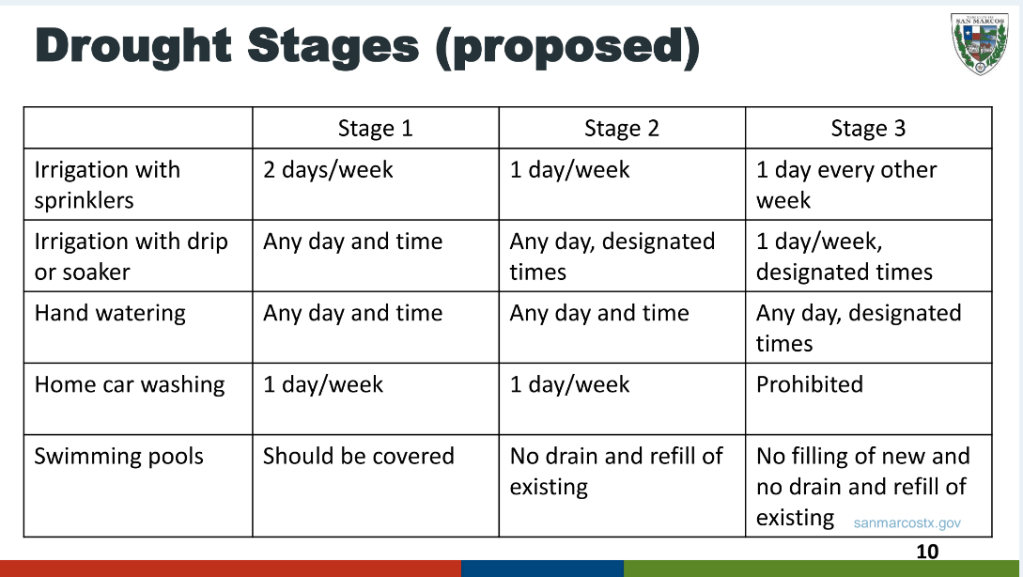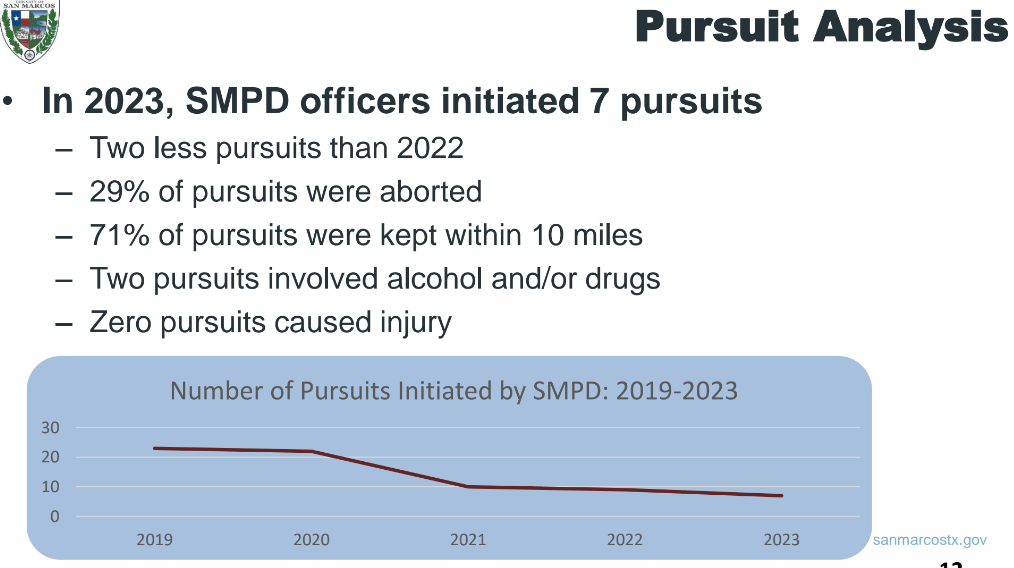We had great workshops this week!
Item 1: Equity Cabinets
(Jude Prather recused himself from the discussion, due to his wife’s employment at Texas State. As far as I can tell, there’s nothing remotely conflict-of-interest about this – but sure, why not.)
I learned that there’s something called an “equity cabinet”. You pull together a bunch of people who represent traditionally underrepresented groups in your community, and have them thoroughly study a problem in the community, and make policy recommendations. (Here is the example from the presentation of where it’s been done before.)
Dr. Rosie Ray is a researcher at Texas State (and we’ve seen her before: here and here and here and here and here). She got some funding to partner with the city of San Marcos – if the city is interested – to put together an equity cabinet to study all things transportation-related.
Who exactly are the traditionally underrepresented groups? Biden defines it like so:

Who are the local partners who can put forth good candidates for this cabinet?

What would they be focusing on?

So about 10 people would be chosen to work closely together over five months. They’d get paid, it would be structured and well-planned, etc etc. The cabinet would have to get up to speed on the challenges that the city faces and what we’re currently doing.
So what does council think?
Everyone’s on board! Sounds like it’s a go.
Here’s the timeline:

I look forward to hearing the recommendations from the cabinet!
….
Item 2: PIT Count
How many homeless people are there? It’s not an easy question to answer, for obvious reasons.
One way you do it is with a “Point in Time” count (ie, a PIT count). You pick one day (in January, per HUD requirements) and get as many volunteers as possible to go out into your county and try to lay eyes on as many homeless people as possible. But also, you talk to the people and try to get a snapshot of the people who are homeless that night.
Homeless Coalition of Hays County conducted ours on January 25th this year. They’re part of the Texas Homeless Network. It took 50 volunteers that day, and 17 more doing background work.
It’s not perfect:

But it’s still useful!
Keep in mind that homelessness is complicated:

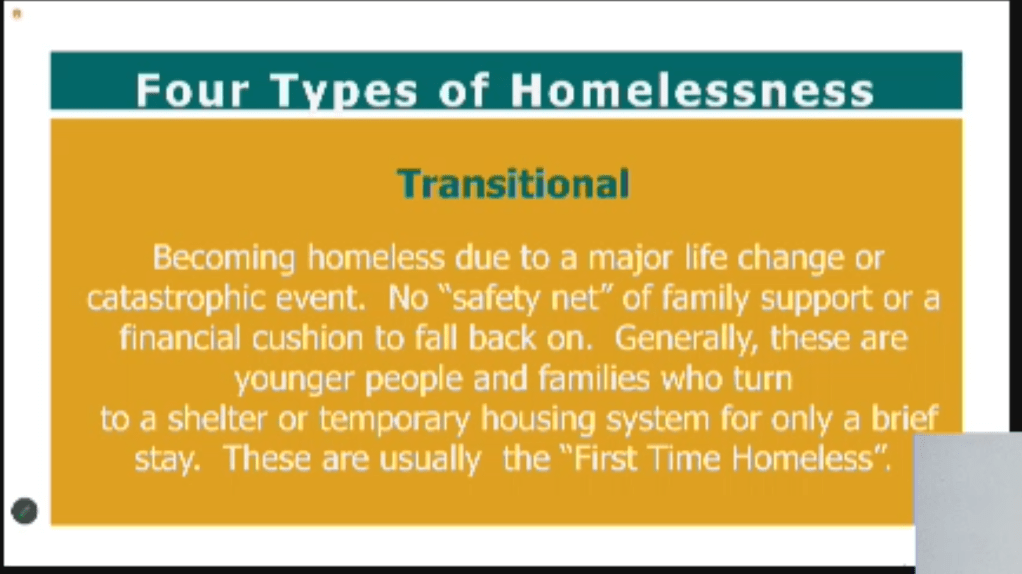


The chronically homeless people are the most visible. These are the people you see along I-35 or in public areas. These are the people most likely to get counted in the PIT count.
The hidden or transitional homeless people are much harder to count. Who knows if you’re couch-surfing, or living in your car? Especially if it’s on-again, off-again? A lot of these people are holding jobs and functioning in society, but can’t afford housing.
Results:
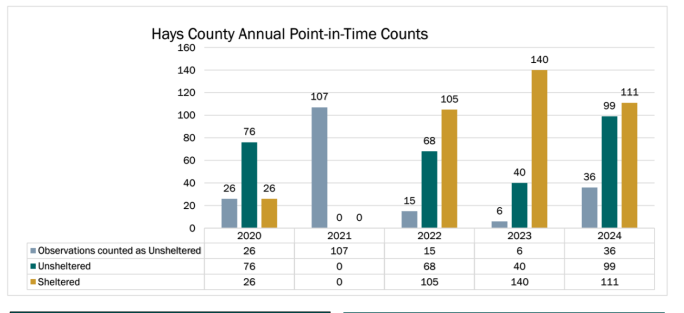
“Sheltered” means Hays County Women’s Shelter or Southside Community Center/BR3T program with motels.
So why is the number of unsheltered people going up? Most likely, it’s two things:
- we’re getting better at locating and counting homeless people, and
- rising housing costs are displacing more people, so there are actually more homeless people.
Where are the homeless people in Hays County?

Mostly in San Marcos.
This also has a couple reasons! We’ve got most of the resources here. But also, the people conducting the PIT count know San Marcos mostly thoroughly. They know where to check in town. We need cooperation from people with deep knowledge of Dripping Springs and Wimberly homeless communities, if we’re going to find and locate people there.
On that day, the PIT Count volunteers make 4 sweeps, but all during daylight, for safety reasons. They also chat with the homeless people, if the person is interested in chatting. So we get some informal survey data.
Survey results:

So what good is this? First, it allows us to apply for lots of funding.
Quick Detour: Remember Robert Marbut, from here and here? He was Trump’s homelessness expert, and then we tapped him to write a Homeless Action Plan for San Marcos.
Marbut advocates for “Treatment First” programs. You do not house someone until they’re stable enough to keep the housing. (If this seems cruel, you might have spotted the fly in the ointment.)
Under the Biden Administration, HUD funds “Housing First” programs. You get someone off the streets, first. Once they have some basic safety and security, then you can work on mental health and addiction issues. (The main argument against this is, “If you offer housing with no strings attached, you’re threatening capitalism! Workers won’t hustle and turn a profit if they’re not scared of having their life crumble!” Mm-hmm.)
Presidents matter. They install people to run all the major organizations, like HUD, the EPA, Dept of Education, DoE, etc. Under Biden, you will have sane people implementing humane policies. Those policies affect things like how cities help homeless people. It really matters.
Anyway, here are the slides from the presentation on why Housing First is more effective than Treatment First:


It’s more effective and less cruel! Win-win.
The PIT count is not the only measure of homelessness. There’s also the McKinney-Vento report for kids enrolled in public schools:

The McKinney-Vento report measures things slightly differently than the PIT Count. They try to record how many kids are couch-surfing, which is the “doubled up” category, and who is temporarily living in a hotel or motel. Whereas the PIT count doesn’t catch either of those unless Southside is paying for the hotel room.
One last note: Jude Prather volunteered at the PIT count, and works in his job to get vets housed, and he deserves some kudos for that hard work.
He also made a point of advocating for increased funding for organizations that provide individual case work for homeless people, which I think is a reference to H.O.M.E. Center.
I agree! They do great work.
…
Item 3: Spin Cycles
You might recognize these scooters from such hits as:
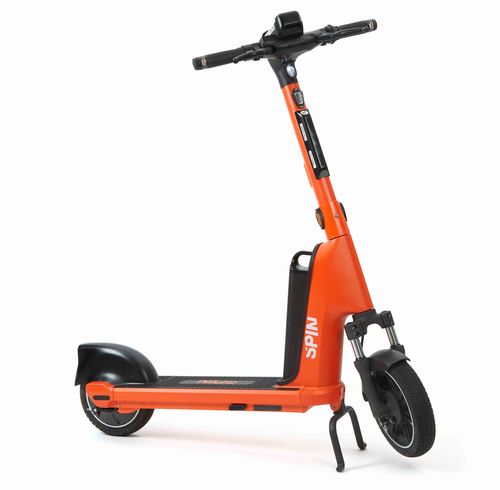
“I’m abandoned, blocking a sidewalk” or “I hope you didn’t need to use a wheelchair on this sidewalk”.
All kidding aside, they popped up in San Marcos back in 2021.
(It’s kind of weird – there’s no history about these scooters on the blog. Council did not discuss them when they were approved in 2021, nor when they were re-upped in 2022. No workshop, no discussion, nada. Did they go straight from Executive Session to the Consent Agenda, with zero public discourse? I think so!)
I’m actually in favor of this kind of thing! I mostly think the program is great (aside from blocking sidewalks).
This is my best guess as to how it works: you download an app. It shows you where the nearest scooter is. You can activate the scooter and ride it within a certain zone. The company is supposed to maintain and insure the scooters, and make sure they get tidied up on a regular basis so that they don’t prevent people in wheelchairs from using the sidewalk once they’re discarded.
Here’s the current boundary of where they work:
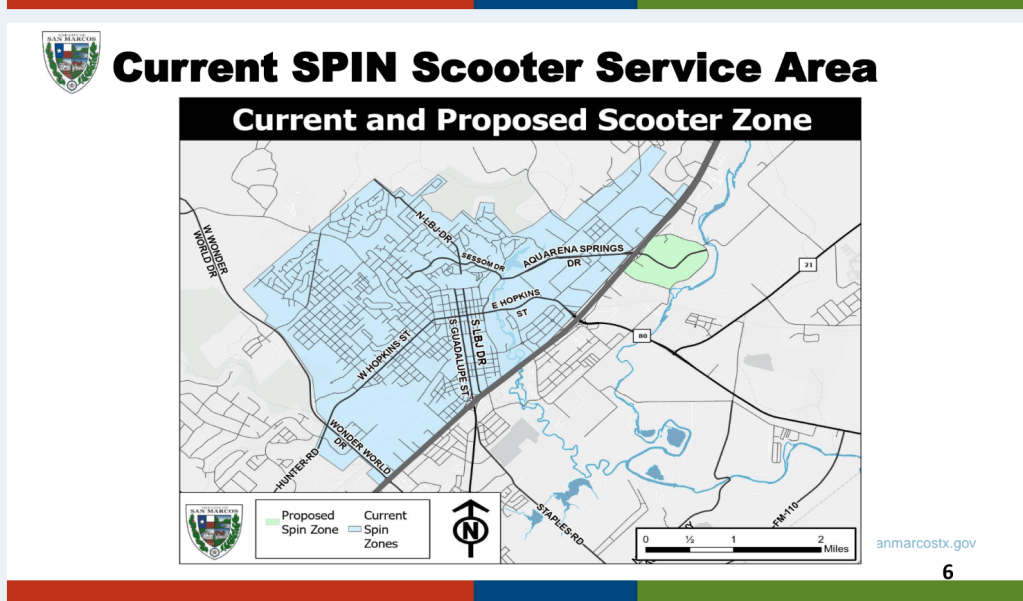
I assume when you hit a boundary, they just deactivate, like a sad ghost who hit the wall of their haunting-perimeter.
They max out at 15 mph, and the company has slow-zones where they max out at 10 mph.
Overall, the program is successful!
- They’re heavily used.
- They’re significantly cheaper than owning a car
- They’re better for the environment.
- They’ve had 1 reported safety incident in 2022-2023.
- They’re great at preventing people in wheelchairs from using the sidewalk. (Kidding. But this is my one major gripe.)
The company is asking for a two things:
- Bigger service area. They want to cross I-35, at Aquarena Springs Road:
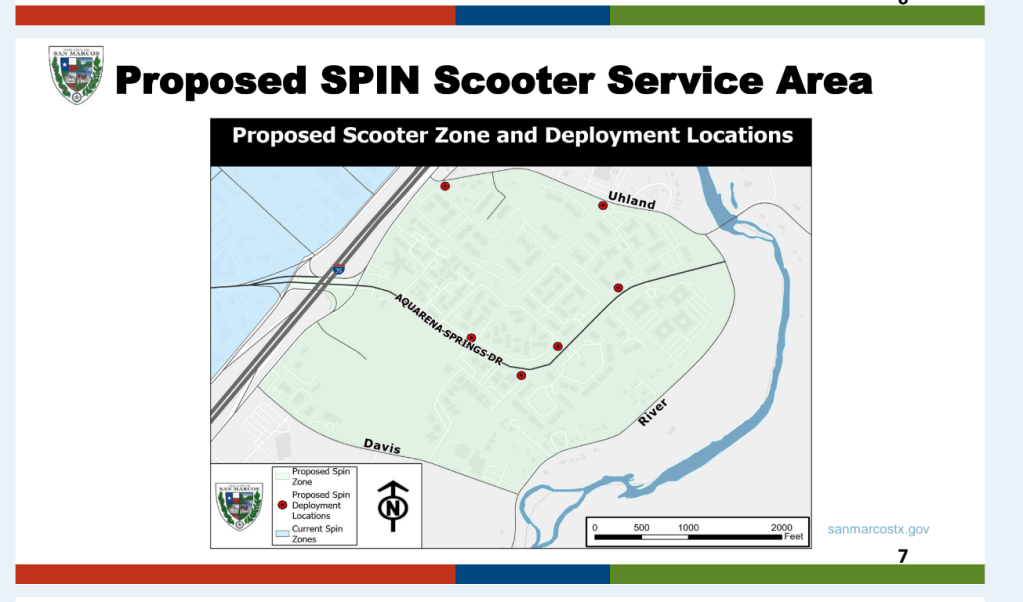
This is a great area to include. There are tons and tons of students there, going back and forth to campus.
The big issue is I-35, of course. (I sometimes fantasize about what it would be like if I-35 had never split this town in half.)
Here’s what they’ll have to navigate safely:

The intersection of Aquarena and I-35 does technically have a sidewalk path that riders can take the entire way, to navigate it.
[Confidential to anyone who drives a car, truck or SUV: People are fragile. Please drive your 2000 lb vehicle timidly.]
2. Their second ask is to operate 24/7.
Right now, the scooters only work 5 am-midnight. So they’re not restricted to daylight hours, but they’re not available when the bars close at 2 am, either. But they’d like to be!
They have some safety options to mitigate things:
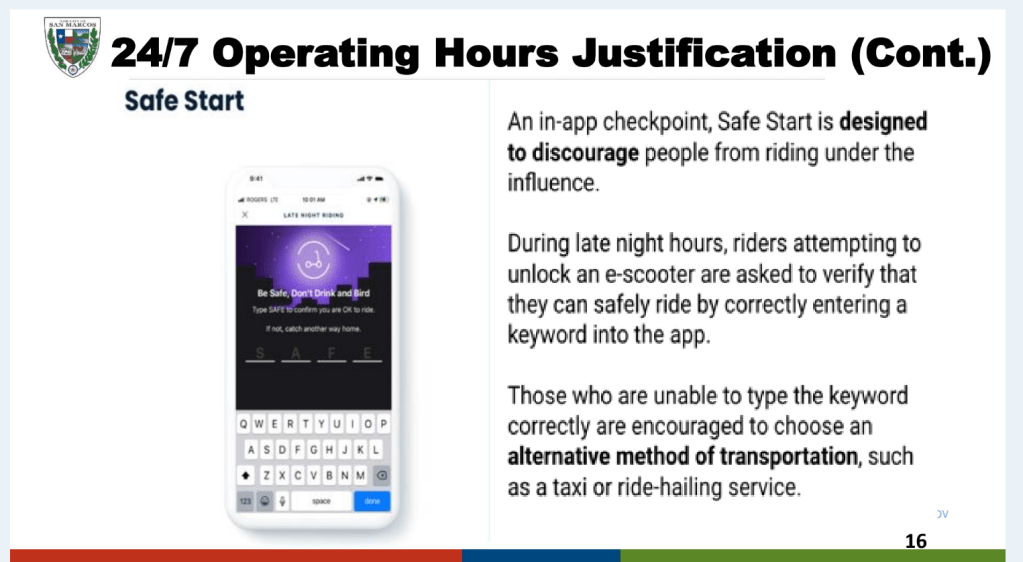
So I guess you can’t be so drunk that your vision is blurring? This seems like a low bar to clear, but at least they’re not getting behind the wheel of a car?
They can also throttle the max speed, and cap them all at 10 mph during overnight hours.
What does Council think?
Jane Hughson is a little wary of the I-35 exchange, and asks if we can put up some signs or markers directing scooters to take that specific sidewalk path.
Answer: sure.
Mark Gleason has some reservations about I-35 as well, but is mostly enthusiastic about looping in the east side and connecting them across 35. He asks if they can extend the zone to Walmart.
(I agree that stretching it to Walmart is a great idea.)
Saul Gonzales asks if you can get a DUI on one of these.
Answer: Yes you can!
In the end, everyone’s on board with this. Also, it’s a pilot program that will come back in 6 months, so we can see how it’s doing.

